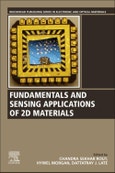Fundamentals and Sensing Applications of 2D Materials provides a comprehensive understanding of a wide range of 2D materials. Examples of fundamental topics include: defect and vacancy engineering, doping and advantages of 2D materials for sensing, 2D materials and composites for sensing, and 2D materials in biosystems. A wide range of applications are addressed, such as gas sensors based on 2D materials, electrochemical glucose sensors, biosensors (enzymatic and non-enzymatic), and printed, stretchable, wearable and flexible biosensors. Due to their sub-nanometer thickness, 2D materials have a high packing density, thus making them suitable for the fabrication of thin film based sensor devices.
Benefiting from their unique physical and chemical properties (e.g. strong mechanical strength, high surface area, unparalleled thermal conductivity, remarkable biocompatibility and ease of functionalization), 2D layered nanomaterials have shown great potential in designing high performance sensor devices.
Please Note: This is an On Demand product, delivery may take up to 11 working days after payment has been received.
Table of Contents
1. Introduction 2. Fundamentals and Properties of 2D Materials in General and Sensing Applications 3. Synthesis, Properties, and Applications of Graphene 4. Synthesis, Characterization, and Properties of Graphene Analogs of 2D Material 5. Electronic Structure and Theoretical Aspects on Sensing Application of 2D Materials 6. Gas Sensors Based on Two-Dimensional Materials and Its Mechanisms 7. Enzymatic and Nonenzymatic Electrochemical Biosensors 8. Electrochemical Sensing Platform Based on Graphene-Metal/Metal Oxide Hybrids for Detection of Metal Ions Contaminants 9. 2D Materials for Field-Effect Transistor Based Biosensors 10. Optical Biochemical Sensors Based on 2D Materials 11. Recent Developments in Graphene-Based Two-Dimensional Heterostructures for Sensing Applications 12. Wearable and Flexible Sensors Based on 2D and Nanomaterials 13. Photo Sensor Based on 2D Materials 14. Future Prospects of 2D Materials for Sensing Applications








